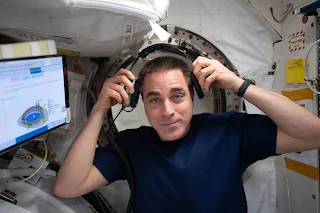I am always fascinated with Earth science and the field of astronomy. I always thought there's something interesting about the universe that people must discover and learn.
That's how I started dreaming to go into adventure and explore the world because a vast of learning is just out there, waiting to be discovered.
During my elementary years, I was intrigued with the story of Apollo 11 and the first people to walk on the moon's surface, I thought it was cool and out of the ordinary. Then I've learned that those guys who changed the history of mankind by conquering the moon were astronauts.
But young as I was, I thought astronauts were not real people. I mean, I thought they were demigods, half-human, half-supernatural creatures, because I never thought people could really go into outer space. Like, my God, how could that be? That's next to impossibility!
Then I would read everything about space science and the solar system and what's beyond there.
I was so obsessed with scientists that I thought they were some extraordinary creatures with a unique set of brains. I mean their brains could be very different from ordinary people.
Since then, I became so intrigued with astronauts, spaceflights, spacewalks, and everything about this orbital laboratory in space called ISS.
When the pandemic swept across the world and most countries were put on lockdown, I started turning to my space mission obsession to get rid of the stressful days, watching space exploration and everything about International Space Station and the great people who gone there.
Space Mission
And that's when I learned about Flight Commander, Chris Cassidy, a NASA astronaut and U.S Navy captain, who served this branch of military as Navy SEAL for 10 years.
He had gone to the International Space Station three times! Wheeew. I thought he must be some kind of a genius to be entrusted with the space mission that frequent.
NASA has a high standard process of selecting candidates to become astronauts. And the trainings are beyond explanation of humanity. Rigid, exhausting and God knows what else. Sending individual to ISS more than once is some kind of an achievement beyond words.
The New Englander
While reading his NASA profile, I have learned that Captain Cassidy grew up around the New England region, which is my super favorite part of the United States.
NE region is basically a former British territory composed of six states: Massachusetts, Connecticut, Vermont, Rhode Island, New Hampshire, and Maine.
I am so obsessed with the New England region that I used it as the location of The Red Star Tattoo Conspiracy, my debut novel. The main setting is Maine, my favorite among the six New England States. And Captain Cassidy grew up in Maine!
I haven't gone to the U.S so I relied heavily on research while writing the book. And became so fascinated with Portland and Cape Elizabeth.
Get to know Capt. Chris Cassidy
Christopher John "Chris" Cassidy was born on January 4, 1970 in Salem, Massachusetts but reportedly grew up in the York County of Maine where he finished his high school.
He then went on to attend the Naval Academy preparatory school in Rhode Island and received his Bachelor of Science in Mathematics degree at the U.S Naval Academy in 1993.
He obtained his Master of Science degree in Ocean Engineering at the very prestigious Massachusetts Institute of Technology (MIT, ranked recently as the world's number one school in the world university ranking) in 2000 and honorary PhD from Husson University.
He is part of the elite military force of the U.S Navy, the Navy SEAL and has been on many combat missions outside the United States.
After the 9/11 attack, he served as ground assault force commander for international and U.S-only combat missions in Afghanistan. He achieved the rank of a captain in the U.S Navy in 2014.
NASA Astronaut
In May 2004, he was chosen by NASA as astronaut, completing his Astronaut Candidate training in 2006.
He first served as a Capsule Communicator in the Mission Control Center of NASA. He became Chief of the Astronaut Office of NASA in 2015 until 2017.
He was first launched into space in 2009 as a Mission Specialist aboard the Endeavour, their mission was to deliver the Japanese Experiment Module Exposed Facility and the Experiment Logistics Module Exposed Section into the International Space Station.
His second spaceflight to ISS was in 2013 when he joined the crew of Expedition 35/36 aboard the Soyuz module as a Flight Engineer. There, he made his first spacewalks.
On April 9, 2020, Captain Cassidy carried his third space mission to the International Space Station with two cosmonauts, Ivan Vagner and Anatoly Ivanishin, this time as a Flight Commander, aboard the Soyuz rocket. They were launched into space from Baikonur Commodore in Kazakhstan.
During this mission, he was seen taking four spacewalks, with fellow NASA astronaut, Bob Behnken, to upgrade the ISS batteries.
During his recent six-month stay at the ISS, he conducted scientific research and contributed to hundreds of scientific experiments including a study of the influence of gravity on electrolytic gas evolution.
He also conducted research for the Onco-Selectors experiment, which leverages microgravity to identify targeted cancer therapies.
After 196 days outside the Earth's atmosphere, on October 21, 2020, Captain Cassidy, Ivan Vagner and Anatoly Ivanishin returned to Earth, and landed safely at Dzhezkazgan in Kazakhstan at 9:00 in the morning.
Captain Cassidy was flown home via a NASA aircraft to Houston, Texas, afterwards.
With this recent space mission, Captain Chris Cassidy completed 10 spacewalks, placing him second, and tying with Bob Behnken, as a NASA astronaut with the most number of spacewalks. He is also the second U.S Navy SEAL to fly in space.
What makes this recent space mission very special to Captain Chris Cassidy is that the International Space Station celebrates its 20th year of continuous human presence, testing technologies, conducting research, and developing the skills needed to explore farther from the Earth.
The Elite World of Astronauts
Breaking into the elite world of NASA is a very ambitious task for any person to achieve because of its highly esteemed standard and difficult process of selection.
One needs to have a superior skill in the field of science and aeronautics, high academic achievement from elite schools, athleticism, and physical endurance to be qualified.
And that's something incredible to fulfill. Many have tried but only few have chosen to be part of NASA.
International Space Station
The International Space Station is a modular laboratory and artificial satellite floating like a complex machine outside the Earth atmosphere.
It is a collaborative project of five space agencies: NASA of the United States, ESA of Europe, Roscosmos of Russia, JAXA of Japan, and CSA of Canada.
It served as an orbital laboratory for astronauts to conduct scientific research and space observation for the improvement of life on Earth and the study of astronomy.
It also serves as an artificial sattelite where astronauts and NASA authorities study the Earth and its behavior especially the weather. They're able to figure out movements of storm, hurricane and severe typhoon.
This year, 2020, ISS celebrates its 20 years of continuous human presence and floating home for astronauts. More than 200 astronauts and cosmonauts had flown to space and lived in ISS during their space missions in the span of two decades.
Through ISS, we're able to see how people live and survive in space and in a zero gravity environment. The weightlessness and how astronauts carried their day to day life outside our planet.
It's amazing to see them float, eat and drink stuff that roll in the air. I see them having fun. But I wonder how it really feels being out there.
I've learned also through Captain Chris Cassidy's explanation that ISS is just like any machine that will break and explode when crew wouldn't work as one. It will disintegrate when it will hit the earth atmosphere.
Such a complex thing in the orbit. Awe-inspiring and extraordinary. A great achievement of mankind in the field of innovation and science. I've great respect to people behind space agencies and astronauts. Great minds!
Back to Captain Cassidy
As with most U.S Navy SEALs, Captain Cassidy is very athletic and loves adventure. He likes biking, traveling, camping, skiing, running, and basketball.
I've watched all his activities through videos while at the ISS and I loved his wit and humor. He's far from a boring geek who thinks about scientific study alone.
He cracks jokes also. He loves adventure like any regular human being. A reminder for me that indeed, astronauts are normal people.
He is also an Amateur Radio operator and once recorded a music video of "It's A Great Day To Be Alive" by Travis Tritt while at the ISS. He was playfully lip synching and had shown what life feels like in space.
He also dedicated it to the health workers fighting the dreaded COVID-19, trying to save lives. The heartwarming video accompanied a caption that said:
"From 250 miles above the Earth, Expedition 63 is very much aware of the hard times which exist in the neighborhoods of the world rotating below. Even amid the uncertainty and difficulties of battling through these challenging times, we encourage everyone to be the best crewmates and take care of each other. Cherish the people you love".



























0 Comments